In the animal kingdom, reproduction occurs in many ways. Pregnancies also look very different, from the asexual reproduction of worms and starfish to humans’ complex reproduction patterns. But it is not just the process of reproduction alone that is diverse; the varying gestation lengths of each species are also equally interesting! Placental mammals are animals with the longest gestation periods, with some examples being humans, horses, and dogs. Their pregnancies typically range from 2 months to upwards of 2 years! On the other hand, some species give birth to their offspring within just a matter of weeks, denoting some of the shortest gestation periods in the animal kingdom.
While some humans find their nine-month pregnancies to be a long journey, there are many animals out there with even longer gestation periods. Join me as we uncover the top 12 animals with the longest gestation periods. From the sea’s massive marine mammals to the beloved gentle giants of the Savannah, get ready to explore the fascinating world of pregnancies within the animal kingdom!
12. California Sea Lions (350 Days)
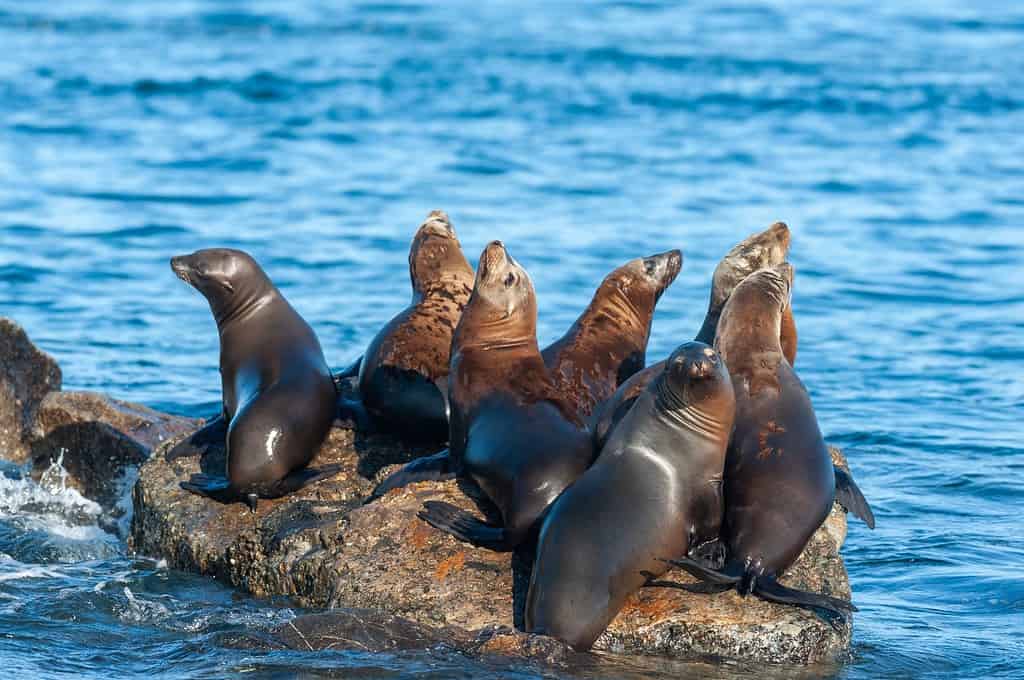
Sea lion
babies, called pups, usually weigh anywhere between 35 and 50 pounds at birth.
©Goldilock Project/Shutterstock.com
California sea lions (Zalophus californianus) are pregnant for approximately 11 to 12 months. Despite being marine mammals, they give birth on land. This usually takes place along the rocky shores of southern or central California, near the Channel Islands Marine Sanctuary or Santa Barbara Island. The only other time in the year sea lions visit these areas is during the breeding season, which takes place from June to August. During this time, they turn the coast into their breeding grounds, otherwise known as rookeries.
Furthermore, healthy female sea lions can have just one pup a year, though they are ready to mate again after just three or four weeks after giving birth. After she has her baby, mother sea lions will nurse for a mere two days before leaving to seek out food. They can be gone for two to five days before they return, relying solely on unique vocalizations and scent to identify her pup’s location. As they get older, the mother leaves for longer lengths of time as she forages for food. Because of this, it is important to leave young sea lions alone if you spot them along the shoreline. It is best to leave seemingly abandoned or distressed pups alone because their mother may truly abandon them if she determines humans are too close.
11. Donkeys (365 Days)

Foals, which are baby donkeys, are typically born at night.
©Geza Farkas/Shutterstock.com
Donkeys (Equus africanus asinus) are a member of the horse family. Moreover, this species is a domestic version of the African wild donkey. It is estimated that over 6,000 years ago, the first donkeys were domesticated in North Africa and Egypt for milk and meat. Today, they are mainly used for farming, construction, and the transportation of people and goods. Donkeys can also be companion animals, pasture pets, or used to guard livestock.
Donkey Pregnancies
Donkey pregnancies are generally 11 to 14 months long, with baby foals weighing anywhere between 18 and 25 pounds at birth. It is most common for them to give birth to just one offspring per pregnancy, but twins are sometimes possible. In this case, sadly, only 14% of donkey twins survive. Having said that, the birthing process is fairly quick, with the process taking only about an hour from start to finish. After that, mothers stay with their offspring for 4 to 6 months. During this time, the mother bathes them, nurses them, and provides all the care they need to be healthy and thrive.
Donkeys are known for their strong maternal instincts, and the bond between the mother and the foal is vital for the foal’s healthy development and safety. For this reason, young donkeys are essentially inseparable from their mothers during the first few months of their lives. Nevertheless, after 6 months, donkeys in captivity will need human intervention to ensure the baby gets used to surviving on its own.
On the other hand, after they are weaned, young donkeys still require plenty of social interaction with other animals. This helps to ensure they maintain their mental health and well-being. It should be noted that donkeys are extremely social herd animals and are much happier when kept with other donkeys.
10. Alpacas (335-366 Days)
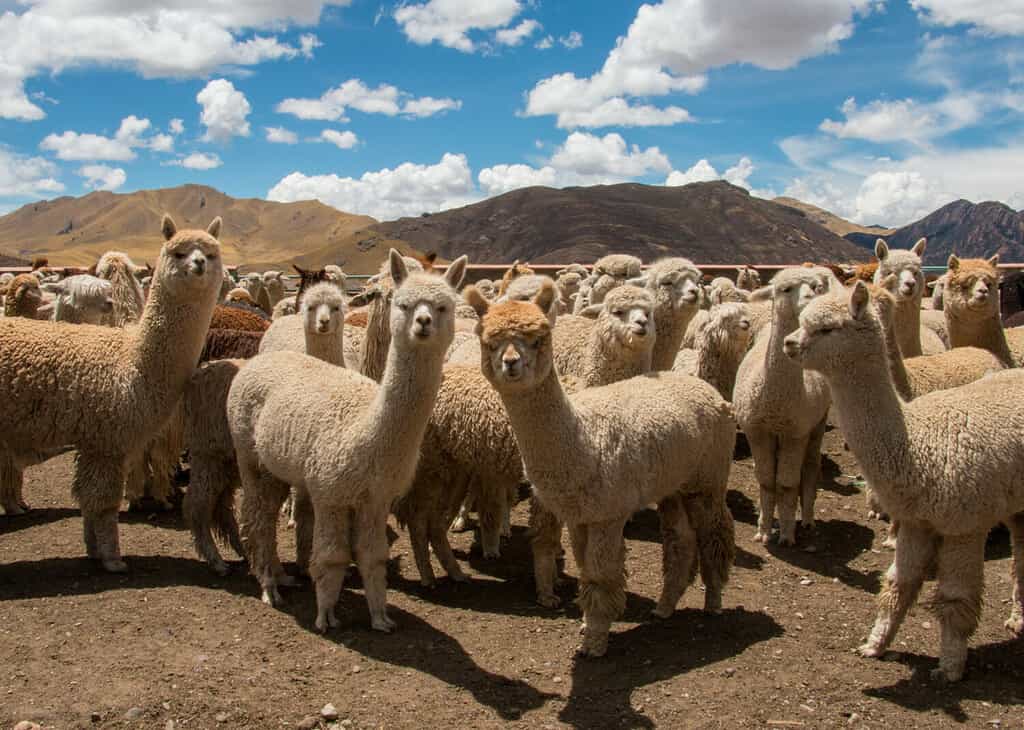
Alpacas are often born during the early morning or afternoon hours — between 7 am and 3 pm — and nurse immediately after birth.
©NewmanFilm/Shutterstock.com
Native to South America, alpacas (Vicugna pacos) are part of the camelid family. They are closely related to Bactrian and Dromedary camels, with similar slender bodies and long necks. Alpacas are found most predominately in the Altiplano region of the Andes, but they also exist in the wild throughout parts of Peru, Chile, and Bolivia. This species was domesticated about 6,000 years ago by the Andean people, who used their soft fleece wool to make clothing, fabric, and other natural fibers. This is because the material is lightweight and fluffy, yet it provides warmth and strong durability. Additionally, the Incan people relied on alpacas as a vital source of meat. Today, domesticated alpacas are utilized across the U.S., with the largest concentrations in Ohio, Washington, Oregon, Colorado, and California.
Now that you know more about alpacas, let’s dive into their gestation periods. Alpaca pregnancies last 11.5 months on average and generally result in only one offspring. Babies, which are called cria, are largely born during the day in spring — between May and September. Mothers nurse their babies for anywhere between 6 and 8 months. Interestingly enough, alpacas have a harem social structure, meaning a group of females is associated with just one single male. This is similar to a variety of other animals like red deer, fur seals, and chimpanzees.
9. Zebras (361-390 Days)
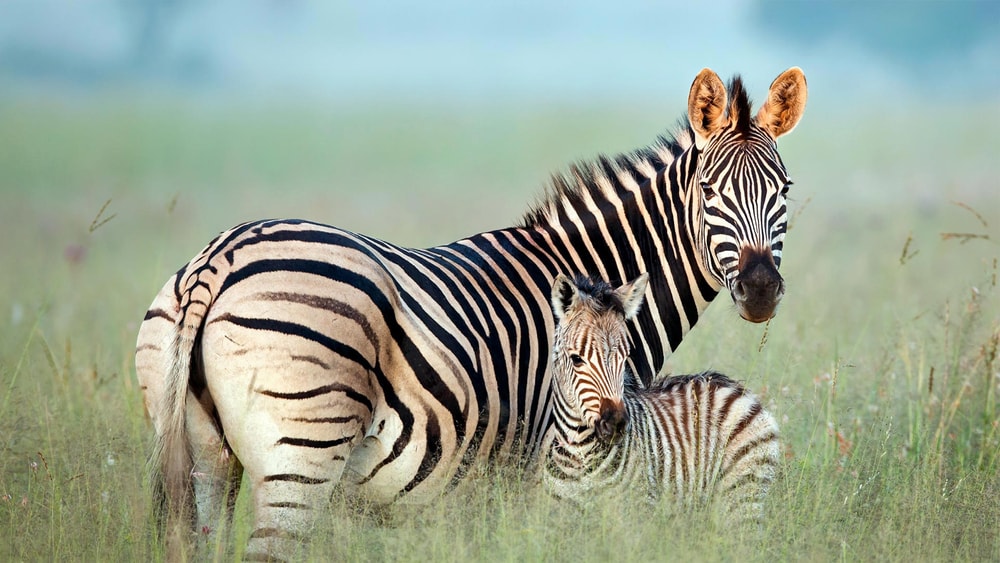
Baby zebras are called foals.
©Shllabadibum Bubidibam/Shutterstock.com
Grant’s zebras (Equus quagga boehmi) are native to the grasslands and woodlands of southeast Africa. This species is just one subspecies of the plains zebra, otherwise known as the common zebra, painted zebra, or Burchell’s zebra. They are unique due to their specialized resistance to many of the diseases that kill other cattle. Furthermore, they have adapted to thrive in their environment due to a reliance on a simple diet of easy-to-find grasses, leaves, shrubs, and bark. Grant’s zebras typically live up to 30 years in captivity or 20 years in the wild. This subspecies of zebra, unlike the Grevy’s zebra or mountain zebra, is not endangered or threatened. The main reason for this is that they face no significant threats other than habitat loss and predation. In fact, there are more Grant’s zebras in the wild today than any other subspecies of zebras!
Even though they are not considered an endangered species, a whopping 50% of all Grant’s zebras born in the wild are killed by predators. Because of this, this species has adapted in a few different ways. To start, their gestation periods last anywhere from 11 to 12 months. Once born, foals can stand and even walk in as little as 15 to 20 minutes after birth. In addition, they can run within an hour! This is important because the mare, or female zebra, needs to keep moving with the herd to find food and water. The mother zebra guides and protects her foal, but it is common for the pair to form small family groups with other zebras in the herd. Grant’s zebras also become independent from their mother much sooner than other equids, which further increases their overall chances of survival.
8. Manatees (390 Days)
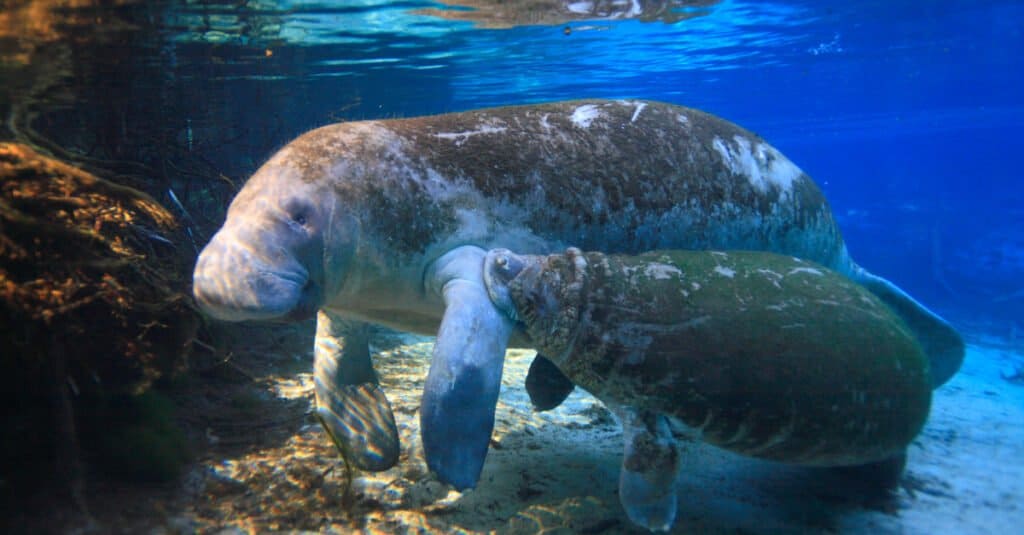
Mother manatees, referred to as cows, nurse their young for one to two years. During this time, calves remain entirely dependent on their mothers.
©Thierry Eidenweil/Shutterstock.com
There are three species of manatees, nicknamed the cows of the sea. This includes the West Indian manatee, the African manatee, and the Amazonian manatee. They are native to the United States, the Caribbean, and Central America, as well as the Amazon River and the west coast of Africa. Nevertheless, they prefer warm water and cannot survive in water temperatures that dip below 60 degrees. Besides that, manatees typically eat seagrass and move at a pace of about 5 miles per hour, which are two other factors that contribute to their unique nickname.
Furthermore, manatees (Trichechus manatus manatus) are another one of the animals with the longest gestation periods. Their pregnancies average 12 to 13 months, resulting in a single calf. Generally, the manatee calf stays with its mother for a period of about two years. During this time, their moms nurse them and teach them crucial survival skills. Additionally, the calf learns about key resting areas, travel routes, and where to find warm waters as the seasons shift. Though manatees have a lifespan of 50 to 60 years — or more — in the wild, only about half of all manatees will survive through their 20s. This is primarily due to two major threats: loss of habitat and collisions with boats and ships.
7. Tapirs (390 Days)
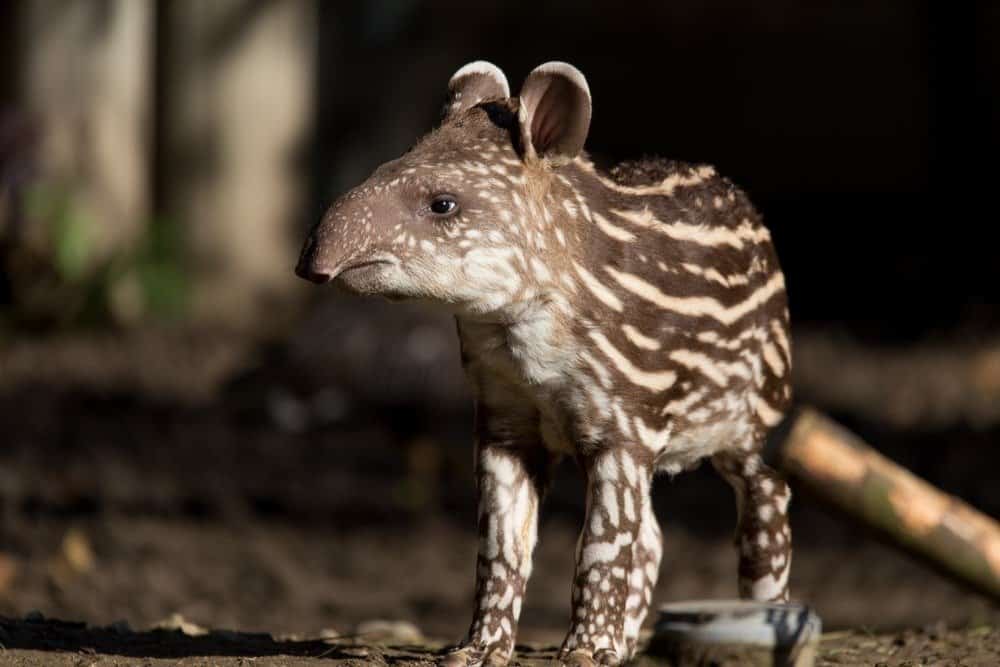
Tapirs are the largest land mammals in South America and resemble a mix between a pig and an
anteater
.
©Artush/Shutterstock.com
If you have never heard of the amazing tapir, they might look a little funny at first. It is not a pig, hippo, or anteater, but this species somehow looks like all three combined! For background, the tapir (Tapirus terrestris) can be traced all the way back to the Eocene Epoch, which took place 33 to 59 million years ago. This alone makes tapirs unique, since that means they have survived numerous extinction waves that forced other animals into extinction. Today, all four tapir varieties are classified as endangered. Having said that, they can be found all over the world and have an estimated population of around 4,500.
Moreover, tapirs are closely related to horses and rhinos, with a distinct prehensile nose that is commonly used for grabbing sticks, leaves, and other vegetation. They are mostly active at night or during dawn and dusk when it is cooler. Tapir forage mostly on grass, plants, and fruit.
Family Dynamics
Furthermore, tapirs are shy animals that live primarily solitary lives. That is, except for when a mother has offspring. Then, they are known to live in small groups called candles, which usually consist of a mother and her calf. This is mainly because the female tapir raises her offspring entirely on her own. Although tapirs mate for life, males often do not stick around to raise their young. Therefore, it is quite rare to find a family of both parents and their offspring living together — though it has been seen in the wild on a few rare occasions.
Besides their familial structure, tapirs are unique for their long gestation periods, which average around 13 to 14 months. They give birth to only one calf per pregnancy, but a healthy adult tapir can produce offspring about every two years. After birth, the mother typically moves to an area with dense vegetation to ensure ample coverage and protection for her baby. Tapir mothers also teach their calves how to swim at an early age to provide another avenue of escape from predators. This also helps keep them cool on hot days. Additionally, when tapirs are young, they have a unique watermelon-like pattern across their bodies. This is to camouflage them with the forest floor, which further protects them from falling victim to predator attacks from animals like jaguars, pumas, and even humans.
6. Camels (360-420 Days)

Before birth, mother camels remove themselves from their herds to find a suitable place to give birth. This preferred birthing environment is often a private area with plentiful vegetation.
©CC BY-SA 3.0 , via Wikimedia Commons – License
The Bactrian camel (Camelus bactrianus), also known as the Mongolian camel, is a two-humped camel species native to Central Asia. The normal gestation period is between 12 and 14 months. Similar to alpacas, this species also has a harem social structure. This means females mate with the dominant male in the group, who then have offspring with multiple other female camels. After birth, the mother cares for her calf, nursing it for upwards of 18 months. Additionally, camels reach full adult size when they are about seven years of age.
5. Giraffes (420-450 Days)

When giraffes are born, they fall about 6 feet to the ground, making it the longest drop of any newborn animal.
©iStock.com/miroslav_1
Giraffes (Giraffa camelopardalis) are some of the most famous animals in the savannah. They are native to central, southern, and sub-Saharan Africa. Their gestation periods last approximately 14 to 15 months and typically result in the birth of a single calf. An interesting fact about this animal is that the mother continuously kicks her newborn baby until it learns to stand. While that might seem unusual, it is obviously quite effective! Not only can baby giraffes run a mere 10 hours after birth, but they can also reach a shocking speed of up to 35 miles per hour!
Baby giraffes are entirely dependent on their mothers for the first 6 to 8 months of life. In addition, it is customary for the calf to be placed in a nursery group with other young giraffes in order to socialize and acquire necessary survival skills. By the time they are 12 to 14 months old, they are considered fully independent giraffes.
4. Rhinoceros (450 Days)

©Bartosz Budrewicz/Shutterstock.com
Baby black rhinoceros weigh anywhere between 80 and 110 pounds at birth.
There are five species of rhinoceros in the world, with the white and black rhinos originating in Africa and the Sumatran, Javan, and greater one-horned rhinos originating in Asia. The black rhino (Diceros bicornis) specifically has the longest gestation periods, averaging around 15 to 16 months in total. Pregnant black rhinos typically give birth to a single calf and temporarily separate from the herd to find a secluded spot safe to give birth.
However, black rhinos are considered critically endangered, with four of the seven types fully extinct in the wild. Humans are at the root of their extinction, with habitat loss and poaching being the two largest contributing factors. They were killed for sport in the early 20th century, whereas in Asia, their horns are highly valued and said to be a cure for various cancers. Additionally, rhino horns were used for ornate purposes in China as far back as 1200 BC. Since they are both grazing animals, they also face severe competition from elephants for food and habitat in the wild. Elephants have unfortunately had more success in their battle for these two already-scarce resources, which has further contributed to the declining population of black rhinos.
3. Walrus (450-590 Days)

Walruses are the only pinnipeds to mate in the winter, which results in a delayed implantation of the fertilized egg. This allows for a synchronized birthing system within the herd.
©thirtydry/iStock via Getty Images
Interestingly, walruses (Odobenus rosmarus) have the longest pregnancies out of all other pinnipeds, with a gestation period lasting around 15 to 16 months. First, pinnipeds refer to a group of mammals that includes three main families: true seals, fur seals, sea lions, and walruses. Baby walruses, or calves, are born with their eyes open and already have fur. Additionally, female walruses and their young form groups called crèches, which are communal care groups for any young walruses in the pod. Moreover, calves are fully dependent on their mothers for at least 18 months — occasionally stretching this relationship for as long as 2 1/2 years. Beyond that point, independent females are placed in the mother’s herd. Alternatively, weaned males remain in the pod for up to three years before they move on to join an all-male herd.
2. Whales (480-590 Days)
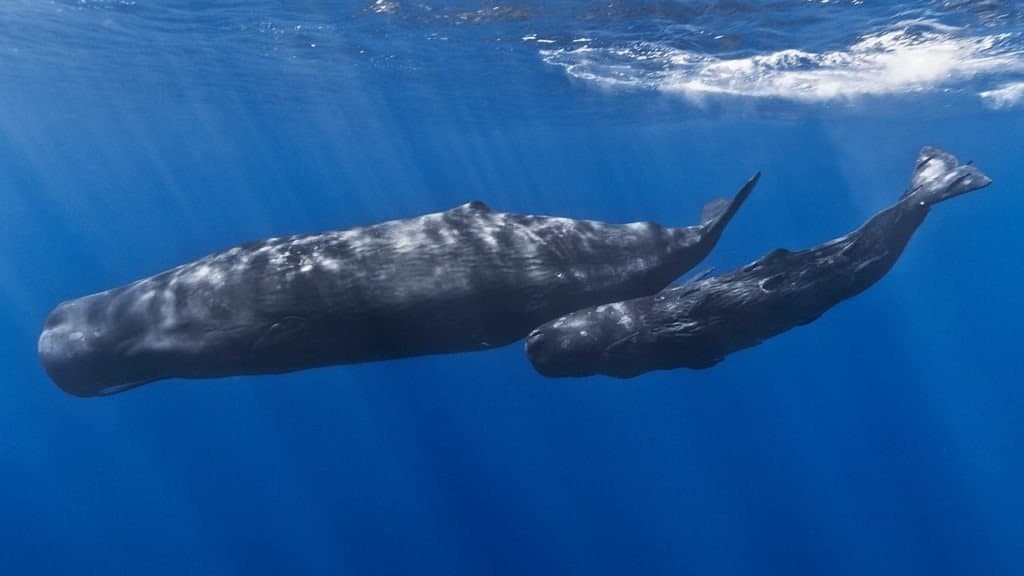
Sperm whale calves average 13 feet in length at the time of their birth.
©Gabriel Barathieu / CC BY-SA 2.0 – License
The largest of the toothed whale species are sperm whales (Physeter macrocephalus), which weigh a massive one ton at birth. Knowing this, it makes sense why sperm whales have the longest gestation periods of any other ocean animal! Their gestation period is typically between 14 and 16 months, which is upwards of 480 days. For up to ten years after birth, the calf remains with its mother, depending on her for care and protection! This is because sperm whale mothers form a strong, stable matrilineal group with their offspring. Sometimes, calves even remain with their mothers for life.
Moreover, sperm whales reach sexual maturity at different ages, depending on their sex. Females mature around 9 years old, whereas males mature between 10 and 12 years old. Healthy females can give birth to a single calf once every four to six years. In rare cases, sperm whales sometimes go as long as 20 years before reproducing again!
1. Elephants (617-646 Days)

Baby elephants are born with curly black or red hair on their foreheads and weigh around 250 pounds!
©Mogens Trolle/Shutterstock.com
Elephants are large herbivores, easily distinguished by their grey, wrinkled skin, long trunks, and massive ears. The African elephant (Loxodonta africana) is the largest land animal on earth today. Adults can weigh over 13,000 pounds and grow to be 10 to 12 feet tall! On the other hand, Asian elephants (Elephas maximus) are much smaller, weighing less than 11,000 pounds and only growing to 7 to 10 feet tall. While these two elephants have many differences, they both share the longest gestation period of any animal on earth!
Their pregnancies last around 22 months, during which time they stick close by their herd for support and protection. After birth, the young elephant is raised within the herd, with both the mother and other female elephants providing care and protection for it. Female offspring stay with their mothers for life, whereas males stay in the herd for an average of 10 years. Even though elephants can live for up to 70 years in the wild, they generally only have about four or five babies.
Summary of the Top 12 Animals with the Longest Gestation Periods
| Rank | Animal | Gestation Length (in Days) |
|---|---|---|
| 1. | Elephant (African and Asian) | 617-645 |
| 2. | Sperm Whale | 480-590 |
| 3. | Walrus | 450-480 |
| 4. | Black Rhinoceros | 450 |
| 5. | Giraffe | 420-450 |
| 6. | Bactrian Camel | 360-420 |
| 7. | Tapir | 390 |
| 8. | Manatee | 390 |
| 9. | Grant’s Zebra | 361-390 |
| 10. | Alpaca | 335-366 |
| 11. | Donkey | 365 |
| 12. | California Sea Lion | 350 |
The photo featured at the top of this post is © iStock.com/WillieErasmus
Thank you for reading! Have some feedback for us? Contact the AZ Animals editorial team.







